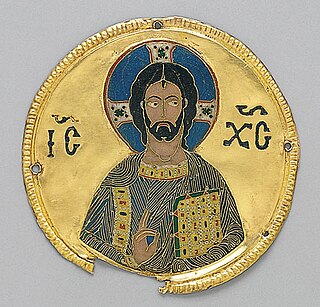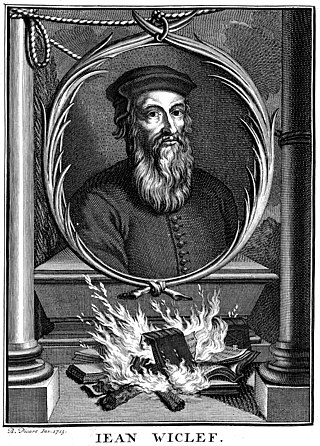Related Research Articles

Bernard of Clairvaux, O. Cist., venerated as Saint Bernard, was an abbot, mystic, co-founder of the Knights Templar, and a major leader in the reformation of the Benedictine Order through the nascent Cistercian Order.
Catharism was a Christian dualist or Gnostic movement between the 12th and 14th centuries which thrived in Southern Europe, particularly in northern Italy and southern France. Followers were described as Cathars and referred to themselves as Good Christians; in modern times, they are mainly remembered for a prolonged period of mutual conflict and religious persecution – widely regarded as genocide – by the Catholic Church which deemed Catharism a heretical sect.

Year 1119 (MCXIX) was a common year starting on Wednesday of the Julian calendar.
Pope Leo VII was the bishop of Rome and nominal ruler of the Papal States from 3 January 936 to his death.

The Albigensian Crusade or the Cathar Crusade was a military and ideological campaign initiated by Pope Innocent III to eliminate Catharism in Languedoc, what is now southern France. The Crusade was prosecuted primarily by the French crown and promptly took on a political aspect. It resulted in the significant reduction of practicing Cathars and a realignment of the County of Toulouse with the French crown. The distinct regional culture of Languedoc was also diminished.
The Second Council of the Lateran was the tenth ecumenical council recognized by the Catholic Church. It was convened by Pope Innocent II in April 1139 and attended by close to a thousand clerics. Its immediate task was to neutralise the after-effects of the schism which had arisen after the death of Pope Honorius II in 1130 and the papal election that year that established Pietro Pierleoni as the antipope Anacletus II.
The Euchites or Messalians were a Christian sect from Mesopotamia that spread to Asia Minor and Thrace. The name 'Messalian' comes from the Syriac ܡܨܠܝܢܐ, mṣallyānā, meaning 'one who prays'. The Greek translation is εὐχίτης, euchitēs, meaning the same.
Peter of Bruys was a medieval French religious teacher. He was called a heresiarch by the Roman Catholic Church because he opposed infant baptism, the erecting of churches and the veneration of crosses, the doctrine of transubstantiation and prayers for the dead. An angry Roman Catholic mob murdered him in or around 1131.

Raymond V was Count of Toulouse from 1148 until his death in 1194.

Peter the Venerable, also known as Peter of Montboissier, was the abbot of the Benedictine abbey of Cluny. He has been honored as a saint, though he was never canonized in the Middle Ages. Since in 1862 Pope Pius IX confirmed his historical cult, and the Martyrologium Romanum, issued by the Holy See in 2004, regards him as a Blessed.
Alberic of Ostia (1080–1148) was a Benedictine monk, and Cardinal Bishop of Ostia from 1138 to 1148.
Geoffrey of Clairvaux, or Geoffrey of Auxerre, was the secretary and biographer of Bernard of Clairvaux and later abbot of a number of monasteries in the Cistercian tradition.

Henry of Marcy, or Henri de Marsiac, was a Cistercian abbot, first of Hautecombe in Savoy (1160–1177), and then of Clairvaux, from 1177 until 1179. He was created Cardinal Bishop of Albano by Pope Alexander III at the Third Lateran Council in 1179.

Tanchelm, also known as Tanchelm of Antwerp, Tanchelijn, Tanquelin or Tanchelin, was an itinerant preacher critical of the established Roman Catholic church, active in the Low Countries around the beginning of the 12th century.

Christianity in the 12th century was marked by scholastic development and monastic reforms in the western church and a continuation of the Crusades, namely with the Second Crusade in the Holy Land.
Hugh of Amiens, also known as Hugh de Boves, monk of Cluny, prior of Limoges, prior of Lewes, abbot of Reading and archbishop of Rouen, was a 12th-century Picard-French Benedictine prelate.
Apostolici, Apostolic Brethren, or Apostles, are the names given to various Christian heretics, whose common doctrinal feature was an ascetic rigidity of morals, which made them reject property and marriage.

Proto-Protestantism, also called pre-Protestantism, refers to individuals and movements that propagated ideas similar to Protestantism before 1517, which historians usually regard as the starting year for the Reformation era. The relationship between medieval sects and Protestantism is an issue that has been debated by historians.

Timothy of Constantinople was a Chalcedonian Christian heresiologist and presbyter of the church of Hagia Sophia in Constantinople. He wrote a treatise in Greek on Christian heresies from a Chalcedonian perspective, On Those Who Enter the Church, or On the Reception of Heretics. This pastoral work is best described as "a handbook on the procedure for admitting heretics to the church".
The Council of Pisa, was convened by Pope Innocent II in May 1135. An extraordinary number of prelates, archbishops, bishops, monks, and abbots attended the council, including a large number of Italian clergy. The council addressed simony, schismatic clerics, heresy, as well as donations to the Templar Order. Pisa would be the third council Innocent would convene to address issues within the Catholic Church.
References
- ↑ Costen, Michael D. (1997). The Cathars and the Albigensian Crusade . Manchester and New York: Manchester University Press. p. 84. ISBN 0-7190-4331-X.
sacraments.
- 1 2 3 4 Alphandéry 1911, p. 298.
- ↑ Moore, R. I. (1995). The birth of popular heresy. Toronto: University of Toronto Press in association with the Medieval Academy of America. p. 36. ISBN 0-8020-7659-9. OCLC 33104971.
- ↑ "Henry of Lausanne", The Concise Oxford Dictionary of the Christian Church, OUP
- ↑ Walker 2014, p. 298.
- ↑ Müller, Daniela, "Henry of Lausanne", Religion Past and Present. Brill, 2006 ISBN 9789004146662
- ↑ Weber, Nicholas. "Petrobrusians." The Catholic Encyclopedia Vol. 11. New York: Robert Appleton Company, 1911. 12 May 2020
 This article incorporates text from this source, which is in the public domain .
This article incorporates text from this source, which is in the public domain . - 1 2 3 4 Alphandéry 1911, p. 299.
- ↑ Moore 1995, p. 39.
- ↑ Watchtower, August 15, 2012, page 18

